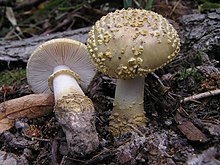| Amanita franchetii | |
|---|---|

| |
| European Amanita franchetii (Boud.) Fayod, Craula, Hörselberg-Hainich, Thüringia, Germany | |
| Scientific classification | |
| Domain: | Eukaryota |
| Kingdom: | Fungi |
| Division: | Basidiomycota |
| Class: | Agaricomycetes |
| Order: | Agaricales |
| Family: | Amanitaceae |
| Genus: | Amanita |
| Species: | A. franchetii |
| Binomial name | |
| Amanita franchetii (Boud.) Fayod | |
| Varieties | |
|
A. franchetii (Boud.) Fayod var. franchetii | |
| Synonyms | |
|
Amanita aspera var. franchetii Boud. | |
| Amanita franchetii | |
|---|---|
| Gills on hymenium | |
| Cap is flat or convex | |
| Hymenium is free | |
| Stipe has a ring and volva | |
| Spore print is white | |
| Ecology is mycorrhizal | |
| Edibility is unknown | |
Amanita franchetii, also known as the yellow veiled amanita, or Franchet's amanita, is a species of fungus in the family Amanitaceae.
Taxonomy
It was given its current name by Swiss mycologist Victor Fayod in 1889 in honor of French botanist Adrien René Franchet.
A. aspera is a synonym of A. franchetii.
There exists a variety known as A. franchetii var. lactella that is entirely white except for the bright yellow universal veil remnants.
Description
The cap is 5–12 centimetres (2–4+1⁄2 inches) wide, and is yellow-brown to brown in color. The flesh is white or pale yellow, and has a mild odor. The closely spaced gills are the same color as the flesh. The stipe is thick and larger at the base, also white to yellowish; loose areas of yellow veil form on the base. A thick ring is left by the partial veil.
Similar species
A similar fungus in western North America was also referred to as A. franchetii, but was long suspected of being a separate, undescribed species, and in 2013 was formally described under the name A. augusta.
Distribution and habitat
A. franchetii occurs in Europe and North Africa with oaks (Quercus ssp.), chestnuts (Castanea ssp.), and pines (Pinus ssp.).
A. franchetii var. lactella is found in the western Mediterranean region, associated with several species of oak (Quercus suber and Q. robur) and hornbeam (Carpinus betulus), and is also reported from Serbia.
Edibility
A. franchetii is considered inedible, and is reported as being toxic when raw or undercooked. Although the species was implicated in the 2005 deaths of ten people in China who displayed symptoms similar to those caused by alpha-Amanitin poisoning, this case report has been called into question for possible misidentification of the mushrooms involved.
See also
References
- Arora, David (1986). Mushrooms demystified: a comprehensive guide to the fleshy fungi (Second ed.). Berkeley: Ten Speed Press. ISBN 978-0-89815-169-5.
- "Standardized Common Names for Wild Species in Canada". National General Status Working Group. 2020.
- Fayod MV (1889). "Prodrome d'une histoire naturelle des Agaricinés". Annales des Sciences Naturelles, Botanique (in French). 9 (VII): 181–411.
- Kuo, M. (March 2005). "Amanita franchetii". MushroomExpert.Com. Retrieved 8 November 2011.
- ^ Tulloss, R.E. (2011). Tulloss RE; Yang ZL (eds.). "Amanita franchetii var. lactella". Amanitaceae studies. Retrieved 7 January 2013.
- Davis, R. Michael; Sommer, Robert; Menge, John A. (2012). Field Guide to Mushrooms of Western North America. Berkeley: University of California Press. pp. 68–69. ISBN 978-0-520-95360-4. OCLC 797915861.
- ^ Trudell, Steve; Ammirati, Joe (2009). Mushrooms of the Pacific Northwest. Timber Press Field Guides. Portland, OR: Timber Press. pp. 82–83. ISBN 978-0-88192-935-5.
- ^ Tulloss, R.E. (2011). Tulloss RE; Yang ZL (eds.). "Amanita franchetii". Amanitaceae studies. Retrieved 8 November 2011.
- Bojantchev D, Davis RM. (2013.) Amanita augusta, a new species from California and the Pacific Northwest. Archived 2013-05-02 at the Wayback Machine North American Fungi 8(5):1-11. doi:10.2509/naf2013.008.005
- Lukić N. (2008). "The Distribution and Diversity of Amanita Genus in Central Serbia" (PDF). Kragujevac Journal of Science. 30: 105–115. Archived from the original (PDF) on 2022-04-10. Retrieved 2013-01-08.
- Phillips, Roger (2010). Mushrooms and Other Fungi of North America. Buffalo, NY: Firefly Books. p. 28. ISBN 978-1-55407-651-2.
- Arora, David (1986). Mushrooms demystified : a comprehensive guide to the fleshy fungi (2nd ed.). Berkeley: Ten Speed Press. pp. 278. ISBN 9780898151695.
- Huang, L.; Liu, X. L.; Cao, C. S.; Ying, Q. (22 February 2009). "Outbreak of fatal mushroom poisoning with Amanita franchetii and Ramaria rufescens". BMJ Case Reports. 2009 (feb22 1): bcr0620080327. doi:10.1136/bcr.06.2008.0327. PMC 3029993. PMID 21686856.
- Huang, Liang; Liu, Xue Lan; Cao, Chun Shui; Ying, Qing (22 February 2009). "Outbreak of fatal mushroom poisoning with Amanita franchetii and Ramaria rufescens". PubPeer. 2009: bcr0620080327. doi:10.1136/bcr.06.2008.0327. PMC 3029993. PMID 21686856. Retrieved 2022-07-06.
External links
- Amanita franchetii in Index Fungorum
- "Amanita franchetii". Mykoweb. Archived from the original on 2011-08-05. Retrieved 2011-11-08. - A description of the western North American species.
- Amanita franchetii var. lactella photo, from Aranzadi Society of Sciences, Mycology Gallery.
| Taxon identifiers | |
|---|---|
| Amanita franchetii | |
| Amanita aspera var. franchetii | |
